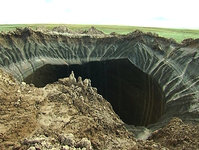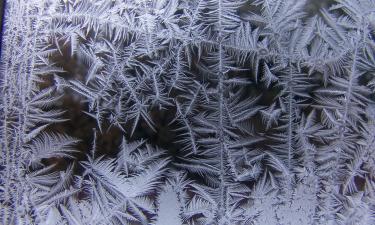Giant sinkhole in Siberia turning into lake

In the Yamal-Nenets Autonomous District of Russia, a team of scientists completed the third scientific expedition to the giant crater that was discovered on the peninsula near the floodplain of the Mord Yaha River last summer. The disсovery received a lot of attention in the media.
For the first time since the discovery, scientists were able to examine the inner part of the sinkhole and take samples of soil and ice for chemical and isotopic analyses, representatives of the regional authorities said.
During the previous expeditions - two of them were attempted in July and August - the interior walls of the sinkhole would crumble and collapse, which prevented the scientists from conducting a full examination. On 8 November, when low temperatures made the soil hard enough, the researchers were able to look inside and find out that the contours of the sinkhole have changed noticeably since the time of the discovery.
The scientists descended into the sinkhole to take samples of soil and ice from its surface. In addition, they used a special probe for ground penetrating radar examination of the hole at a depth of 200 meters. The technology will make it possible to see the visible structure of the hole and create a 3D model of it. The analysis of the bizarre phenomenon will give scientists an opportunity to predict such natural phenomena in the future, a press release said.
The giant crater, the scientists believe, will become a tundra lake in about two years. There are many of such lakes in Yamal, and most of them are of similar origin. However, the nature of such sinkholes still remains unknown - no one knows how they appear and what leads to their appearance.
"Further, our objective is to systematize all data that we have been able to collect so far and develop methods for monitoring to possibly predict the appearance of such a phenomenon," director of the Russian Centre of Arctic Exploration, Vladimir Pushkarev said.
In April 2015, another expedition is planned to conduct geophysical and geological research of the territory around the sinkhole.
On July 10, a video appeared on YouTube showing an aerial view of the giant sinkhole. The hole was found 30 kilometers far from the Bovanenkovsky oil and gas condensate field. The author of the video said that the size of the hole was so large that one could descend into it on several Mi-8 helicopters.
In the course of the first examination of the sinkhole, scientists concluded that the sinkhole was of natural origin and was not a consequence of an anthropogenic impact, such as an explosion or the fall of a meteorite.
The scientists did not detect any dangerous radiation at the site of the sinkhole. The researchers concluded that the hole was the result "of a natural phenomenon, the definition of which can not be given without detailed study."
The diameter of the inner edge of the crater is about 40 meters, and 60 meters on the outside. Fragments of rock were scattered as a result of the emission on the square of 120 meters, senior researcher of the Scientific Research Center of the Arctic, Andrei Plekhanov said. The video shows that the sinkhole is surrounded with vegetation. A closer look on the territory around the object shows rocks scattered around the sinkhole, as it usually happens during explosions. It was also said that there were no research or exploration works conducted in the area of the sinkhole.
Pravda.Ru
Subscribe to Pravda.Ru Telegram channel, Facebook, RSS!




